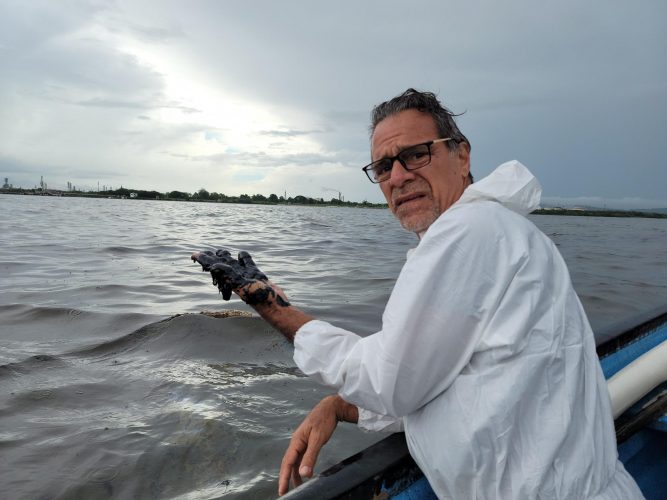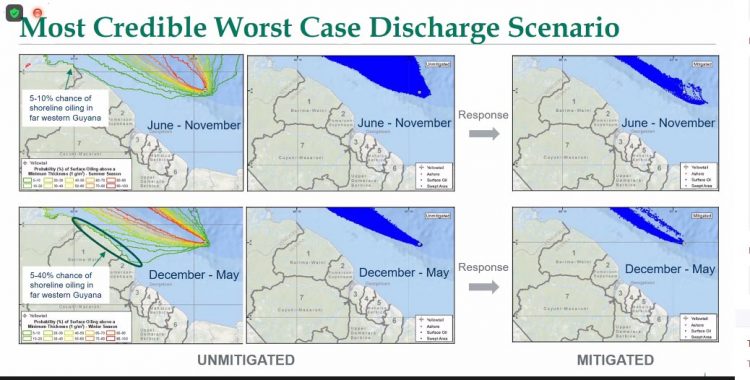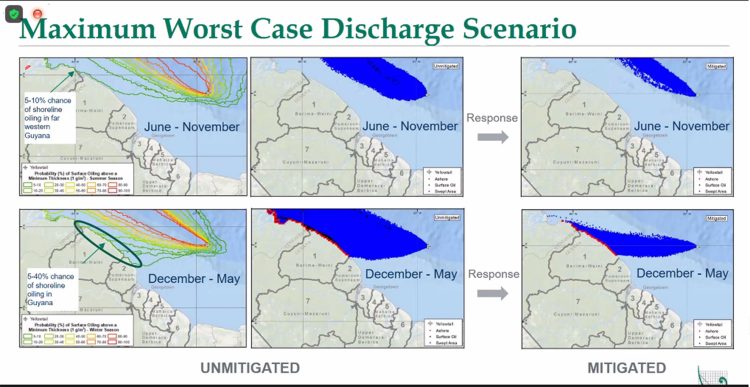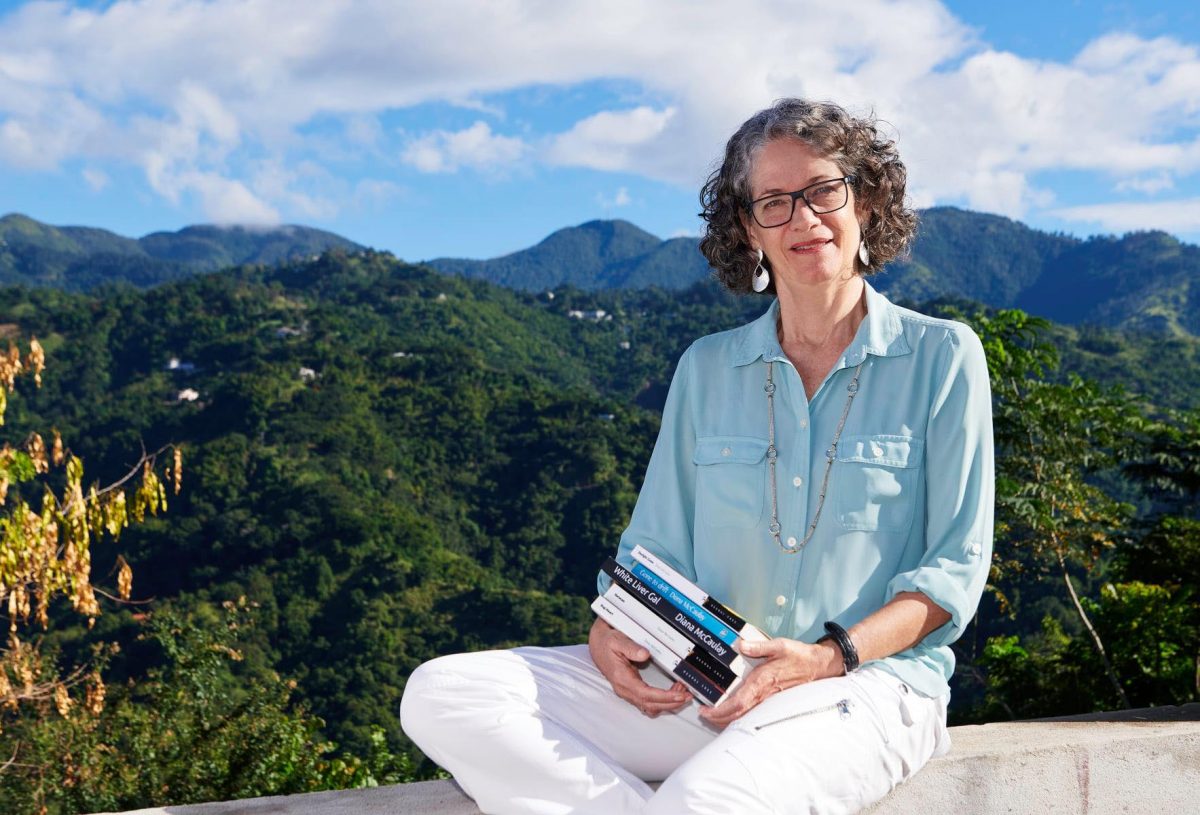Jamaican environmentalist Diana McCaulay has called for the Government of Guyana and its EPA to hold off on approving ExxonMobil’s Yellowtail well in the Stabroek Block until it shares the findings of the Environmental Impact Assessment (EIA) with other Caribbean territories.
McCaulay’s call came last night during a consultation on the Yellowtail EIA hosted by the Environmental Protection Agency (EPA) and the consultancy firm – Environmental Resources Management (ERM). ERM’s Todd Hall presented the virtual gathering with a number of scenarios in relation to “unplanned events” it explored during the compilation of the EIA. Those unplanned events included potential oil spills at the Yellowtail Development.
The gathering heard that an oil spill, whether mitigated or unmitigated, has the potential to impact a number of Caribbean territories along with the northwestern coast of Guyana. Hall explained that it would be a long travel for an oil spill to affect the other regions on Guyana’s coast.

During the question and answer segment, following the presentations from the consultants at ERM, McCaulay used the opportunity to question how Guyana intends to deal with the risks it potentially puts the Caribbean in.
Based on the data presented, should an oil spill occur off the coast of Guyana, crude oil could travel along the north coast of Trinidad and Tobago, to some of the Lesser Antilles, the entire south coast of Jamaica and as far as the Dominican Republic.
“I came here tonight after I became aware of the impacts of oil spill on other Caribbean countries from this project that we are now discussing and I came to say that this EIA must be shared with other Caribbean countries. This is not a Guyana project. This is not only about the impacts to Guyana…So this is not a Guyana business. The EIA is extremely long, and it needs enough time for everyone affected which is not just Guyana to look at it and for there to be discussion between our governments,” McCaulay said.

She added that they are accustomed to hearing about questions and comments being directed to the consultant companies and EPAs when such queries are sought, but pointed out that in the end, it is the governments that grant permission for such operations to commence. Hence, the call for the Government of Guyana to come to the table with the Jamaican and other Caribbean governments.
“What I want to say I’m appalled at the whole sound of this evening (consultation) as if we are discussing something of no (consequence). As a Jamaican, my government needs to liaise with your government and the people in my country and all of the other Caribbean countries need an opportunity to look at the EIA and see what threats are being put on us (and) for what,” the environmental activist related.

She also seized the moment to call for the cessation of all oil drilling activities.
“Is it not abundantly clear to everyone in this virtual room that we have got to move away from oil and gas drilling anywhere in the world…are we really going to allow this to happen in the Caribbean Sea where our governments we know are not capable of holding large multinational companies to account,” she questioned.
“Do we not know what the oil and gas industry has done to the very atmosphere and we are going to sit here this evening as if we are talking about actuarial tables or something that is more boring than you can imagine instead of our survival,” she added.
Legal action
Gary Aboud, Corporate Secretary of the Fishermen and Friends of the Sea (FFOS) in Trinidad also joined the virtual consultation and he threatened legal action against Exxon-Mobil’s subsidiary EEPGL, the EPA and the Guyanese Government if the EIA is not transparently shared with other territories.
“We are willing to litigate if the promises are not written and fair in the first instance to stop the capacity of this approval because of an endangerment of the Caribbean territories. In the second instance, to claim for damages if they fail to commit to their promises in the EIA and if you do then some of us are willing to go the distance to ensure that this project does not continue and that if it continues it must only continue with the direction and discretion as approved by the court. I’m not even sure which court would have jurisdiction…,” Aboud said.
He added that the entire Caribbean should be concerned and questioned the plans for a potential oil spill. Aboud dismissed the ERM and EEPGL’s contention that an oil spill is unlikely to occur and pointed to the many spills in Trinidadian waters.
“I want to state on record and strong objection to hoodwinking the question about preparedness about when they occur because I am not aware of a single oil company on the planet who have not had accidents and spills. So the preparatory planning and the EIA cannot hoodwink the concerns that we are raising. In Trinidad, we probably have the world record for an island with not many installations but quite a few, (and) we have a reported, in excess, of 100 spills per year,” he highlighted.
He pointed to the impact activities in Guyana are already having on the wider Caribbean. High-lighting the fact that Guyana signed on to and ratified the Minamata Convention, which calls for the outlawing of mercury in mining activities, and yet its mining industry is heavily dependent on mercury, Aboud pointed out that the fishery sector in his island nation is being affected.
The fisherfolk representative said that a study was commissioned a few years ago, by the government of Trinidad and Tobago, and it found higher than normal levels of mercury in five of the 16 commercial fish in the island’s waters. He said that mercury-laced water and fish from the Orinoco River may have been partially responsible for the increased mercury in their fish.
“I would like the EIA to include a listing of the emergency response preparedness training for Guyanese nationals, professionals working in that industry and with this company (EEPGL). Secondly, we would like to see included, in the EIA, the list and cost and dates of the arrival of the emergency response preparedness equipment recognizing that this equipment…before any approval is granted in our waters, in our fishery, in our tourism sector, of which we depend on. We need to know exactly what is the real emergency response training, preparedness and equipment preparedness,” Aboud listed as some of the conditions that may dissuade them from seeking legal recourse.
Aboud also called for adequate insurance to protect the environment from the dangers that oil and gas poses.
“I would like to see whether there’s trans-regional insurance cover for the tourism sector. I think that’s critically important. For the fishery sector of which, in Trinidad, we have 50,000 dependents and thirdly, for biodiversity loss. I’ve never heard of an insurance that could cover for biodiversity loss and particularly I’d like to see in the EIA what policy is specifically in place for transnational waste when it crosses borders,” he said.
The representatives of the companies did attempt to answer some of the questions raised by the regional activists but failed to satisfy them.
The virtual gathering heard, from EEPGL’s Steven Laws, that should there be an oil spill then the company has the resources to pay “legitimate costs”. However, he could not explain what qualified as legitimate costs and how that would be calculated.
Additionally, ERM said it did not share the EIA with the other Caribbean territories since it is working within the confines of Guyana, on a Guyanese project, and in accordance with the Environmental Protection Act of Guyana.
Last night’s consultation brought the curtain down on the public consultation phase of the EIA comments period. Persons can still send written comments to the EPA up until December 15, 2021.
EEPGL submitted an application for environmental authorization to the EPA on April 1, 2021 after which the environmental body determined an EIA was required. The EPA published a public notice on May 09, 2021 and held seven scoping consultation meetings between May 27 and June 04, 2021.
The final terms and scope for the EPA was given for the EIA on September 10, 2021 and the consultants connected with over 50 stakeholders including indigenous leaders and villages. The EIA was submitted to the EPA on October 14, a notice published on October 15 and the 60-day comment period commenced.
As part of the Yellowtail Project ExxonMobil plans to drill between 40 and 67 wells for the 20-year duration of the investment. It is intended to be the largest of the four developments with over 250,000 barrels of oil per day targeted once production commences.
Based on the schedule, once approval is granted, engineering commences in 2022 and production in the latter part of 2025.






